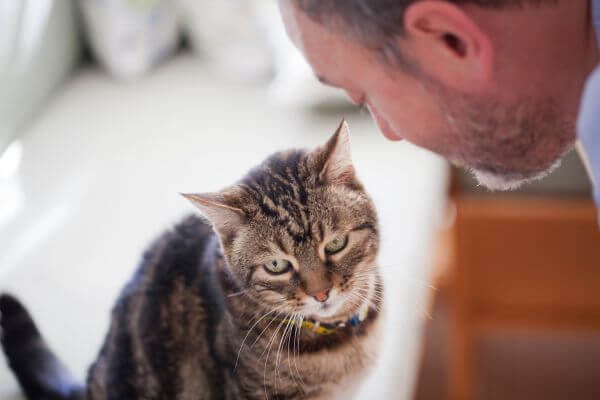Understanding animal behavior is essential for a good relationship with pets. Learn what your pets are trying to say.
Interpreting Your Pets’ Signals

Understanding animals’ signals is fundamental for ensuring their well-being. Dogs, for example, use body language to communicate. A wagging tail can indicate happiness but also anxiety. Therefore, observing the context is essential for correct interpretation.
Additionally, cats are masters at expressing their emotions through gestures and postures. A cat with an upright and slightly curved tail is usually happy. On the other hand, a puffed-up, upright tail can be a sign of fear or aggression. Knowing these signals helps promote harmonious coexistence.
Exotic animals like ferrets and lizards also have specific behaviors. Ferrets show excitement by jumping and running quickly. Lizards, when threatened, may puff up their bodies. Understanding these behavioral peculiarities is crucial for providing an appropriate environment.
Identifying Emotions Through Body Language

Dogs communicate emotions through body language. For example, ears back indicate fear or submission. A dog with erect ears and a relaxed body is confident and calm. Observing these signals is vital to understand what your dog is trying to say.
Cats also use body language to express feelings. A cat rubbing its head against you is showing affection. Conversely, a cat with its ears back and pupils dilated is likely irritated. Paying attention to these small gestures is important.
Ferrets are known for their playful behavior. When excited, they may perform the “weasel war dance,” a series of jumps and somersaults. This behavior is an invitation to play and an expression of happiness. Understanding these signals improves interaction with your ferret.
Understanding Pets’ Sounds and Vocalizations
Dogs use various sounds to communicate. Short, repetitive barks can indicate alertness or excitement. Long, continuous barks often suggest loneliness or boredom. Therefore, interpreting sounds in the appropriate context is crucial to understand what your dog needs.
Cats also vocalize in various ways. A soft meow usually indicates the cat is asking for something, like food or attention. Purring can signify contentment, but it can also be a sign of discomfort. Observing the cat’s overall behavior helps decipher their meows.
Ferrets are relatively quiet animals but can make sounds when excited. Chortles and squeaks are common during vigorous play. These sounds generally indicate joy and excitement. Understanding your pets’ vocalizations is fundamental to meeting their emotional needs.
What Your Pets Are Trying to Say
Dogs are social animals and exhibit many behaviors to communicate their emotions. A dog rolling onto its back is showing submission or asking for a belly rub. This behavior can be a sign of trust in the owner. Therefore, it is important to respond appropriately.
Cats have subtler communication. When a cat rubs against you, it is marking territory and showing affection. Additionally, a cat lying with its belly up is expressing trust and security. Understanding these gestures improves the relationship with your cat.
Lizards, such as leopard geckos, have unique behaviors. A lizard waving its tail is usually feeling threatened. A lizard licking objects around it is exploring and marking territory. Understanding these signals is essential for properly caring for exotic animals.
Importance of Positive Reinforcement in Training
Positive reinforcement is an effective technique for training dogs. Rewarding good behaviors with treats or affection motivates the dog to repeat these behaviors. This technique is especially useful for teaching basic commands, like sit and lie down. Thus, the dog associates the desired behavior with something positive.
Additionally, positive reinforcement promotes a trusting relationship between the owner and the pet. Avoiding punishments and focusing on rewards creates a healthier learning environment. Dogs respond better when encouraged positively. Therefore, it is important to be consistent and patient.
Positive reinforcement can also be applied to cats and other exotic animals. Cats can be trained to use a scratching post with rewards. Leopard geckos can be conditioned to accept handling with treats. Using positive reinforcements makes training an enjoyable experience for both.
Tips for Effective Positive Reinforcement
To apply positive reinforcement effectively, it is important to be consistent. Rewarding immediately after the desired behavior helps the animal understand what it did correctly. Additionally, using treats that the animal truly likes makes training more motivating.
Another tip is to vary the rewards. Alternating between treats, toys, and affection keeps the animal interested. This variation prevents the pet from losing interest and helps keep training fun. Therefore, observe what your animal likes most and use it to your advantage.
Additionally, short and frequent training sessions are more effective than long sessions. Dogs and cats, like other animals, learn better in short periods. This prevents them from becoming bored or stressed. Therefore, plan training sessions of 5 to 10 minutes several times a day.
Common Training Mistakes
A common mistake in training is the lack of patience. Training an animal can take time and requires consistency. Impatience can lead to the use of punishments, which are counterproductive. Therefore, it is important to remain calm and persistent with positive reinforcement.
Another mistake is the lack of clarity in instructions. Inconsistent or confusing commands make it difficult for the animal to learn. Always using the same words and gestures helps the pet understand what is expected. Therefore, be clear and consistent with commands and rewards.
Additionally, many owners do not realize the importance of socializing their pets. Exposing dogs and cats to different environments and situations early on is crucial. This helps prevent aggressive or fearful behaviors. Therefore, include socialization as part of your pet’s training.
Benefits of Training for the Owner
Training your pet brings many benefits to the owner. A well-trained animal is more obedient and easier to control. This facilitates coexistence and makes daily life more enjoyable. Additionally, a trained pet can accompany the owner in more activities.
Training also strengthens the bond between the owner and the pet. Spending time together during training sessions creates a trust relationship. Additionally, understanding and meeting the animal’s needs improves communication. Therefore, investing in training brings emotional benefits for both.
Furthermore, a well-trained pet is less likely to develop problematic behaviors. Avoiding destruction of objects, excessive barking, and aggression are some of the advantages. Therefore, training contributes to a more harmonious and peaceful domestic environment.
Training Pets: Positive Reinforcement and Fun
Training pets using positive reinforcement can be fun. Turning learning into a game keeps the animal interested. For example, teaching basic commands during play sessions makes the process lighter. Thus, the pet learns while having fun.
Additionally, using interactive toys can make training more effective. Toys that dispense treats, for example, are excellent tools. They keep the pet motivated and reward the correct behavior in a fun way. Therefore, integrating toys into training is a great strategy.
Another tip is to vary the training locations. Training in different environments helps the pet generalize the commands. This means that the animal will learn to obey in any situation. Therefore, take your pet to parks, squares, and other places to diversify the training sessions.
The Importance of Routine in Training

Maintaining a routine is essential for effective training. Animals learn better when there is consistency in schedules and methods. Establishing fixed times for training sessions helps create a habit. Thus, the pet knows when to expect lessons and is more receptive.
Additionally, routine helps reinforce desired behaviors. Repeating commands and rewards daily solidifies learning. This is especially important for essential behaviors, such as proper bathroom habits. Therefore, being consistent with the routine is fundamental.
Another advantage of routine is stress reduction. Animals that know what to expect tend to be calmer and more confident. The predictability of training sessions creates a safe environment. Therefore, incorporating training into your pet’s daily routine is beneficial for both.
Training and Animal Welfare Are Linked

Positive training is closely linked to animal welfare. Teaching desirable behaviors through positive reinforcement improves the pet’s quality of life. A well-trained animal is happier and more confident. Therefore, investing in training is a way to care for your pet’s well-being.
Additionally, training prevents problematic behaviors. Animals that receive adequate mental and physical stimulation tend to be more balanced. Training provides these stimuli, keeping the pet active and engaged. Therefore, training contributes to the animal’s mental and physical health.
Finally, training strengthens the relationship between owner and pet. Clear communication and positive interactions create a strong bond. This results in a more harmonious and enjoyable coexistence. Therefore, positive training is beneficial for both the animal and the owner.
Conclusion: The Value of Positive Training for Pets
Training your pet is an enriching experience. Positive training, based on rewards, strengthens the relationship between owner and animal. Understanding animal behavior is essential for harmonious coexistence. This is true for dogs, cats, and even exotic animals.
The benefits of training go beyond obedience. It contributes to the pet’s overall well-being, preventing undesirable behaviors. A well-trained animal is happier, healthier, and more confident. Therefore, dedicating time to training is an investment in your pet’s well-being.
We encourage our readers to explore more about positive training. Visit other pages on our site for detailed tips and effective techniques. Leave a comment sharing your training experiences. Together, we can create a happier and more harmonious environment for our pets.